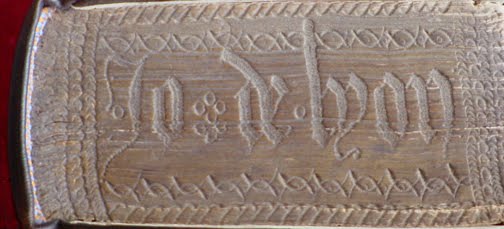 |
| Illustration only, not for sale |
These are signed bindings, not in the sense of carrying the name of the binder, but because they carry the name of their owner.
In keeping with the contemporary practice of storing books flat, a bit of ink (examples below) can do the trick too. Inscribing the title of the book, or the name or initials of the owner on the edges, was part of the behavioral repertoire of owning a book.


What is happening along the edges is considered part of the binding, an area which deserves further study. Our book is also creating meaning on the book edges, but on an altogether different level. For all we know, E.A.M. could be a schoolboy, and Jo de Lyon could be a king. He instructed
his bookbinder to engrave (gauffer) the edges with his name and a motto, and apply a layer of gilt to the ornamented edges. And we read
Jo * de Lyon / vicint * Leo ** de * Tribu / Juda **in an exquisite Gothic font, word spacing marked by floral ornaments and dots, all placed in a double frame of geometrical ornaments. Personal ownership marked in such a dominant mode, such that the owner seems to eclipse the author in importance, is not at all common. But what happens when the owner decides to present this book to a friend or a student? Read on: It is all here for us to see.
